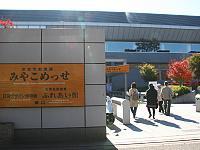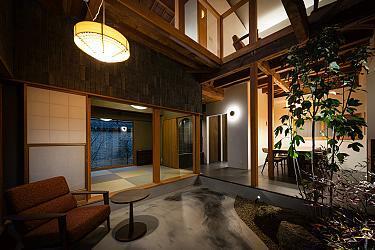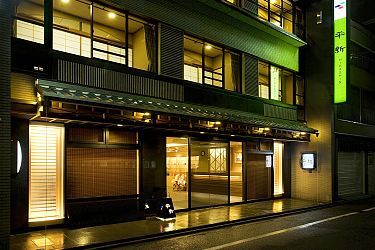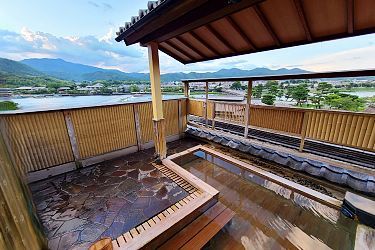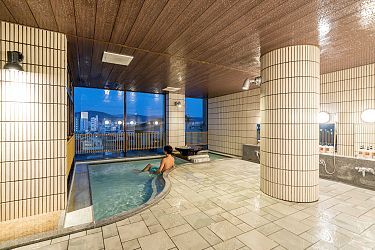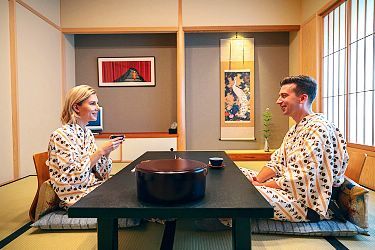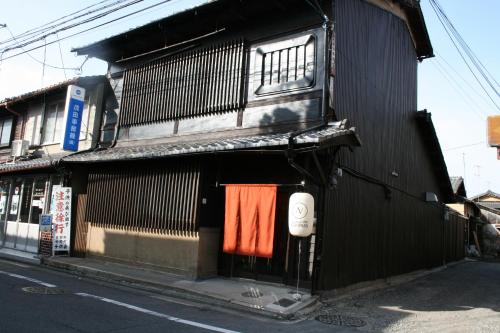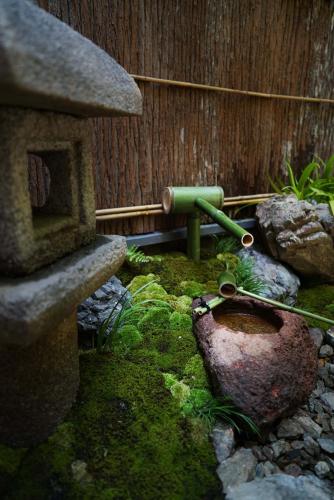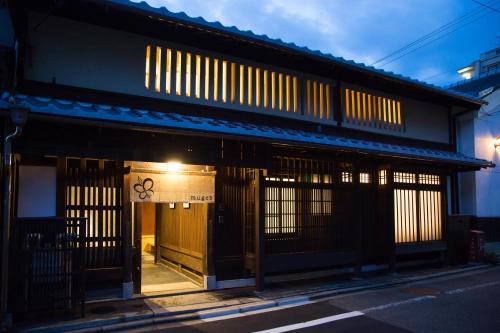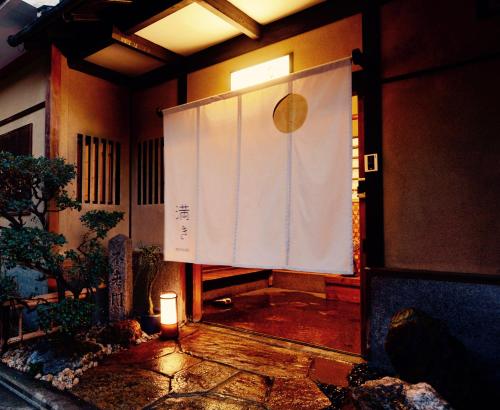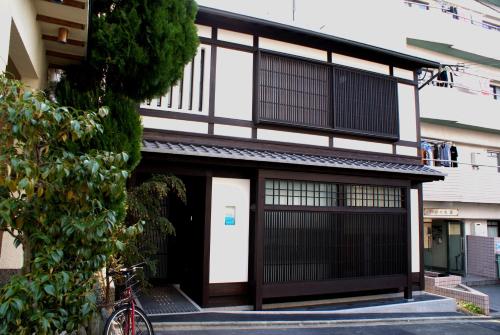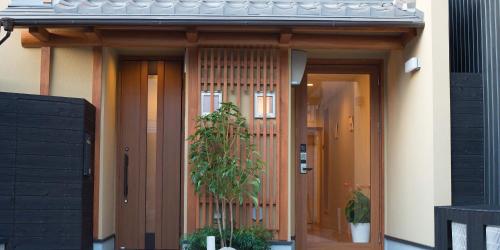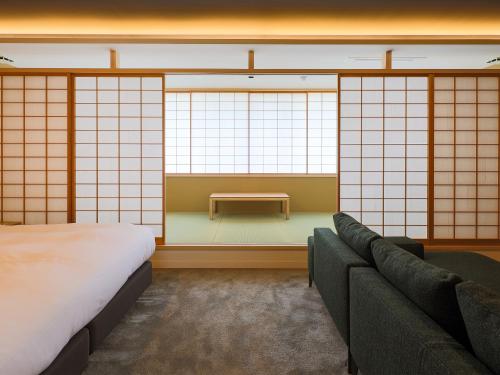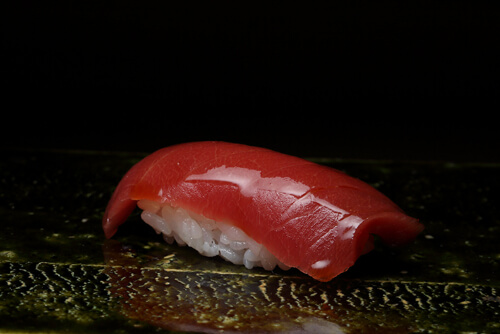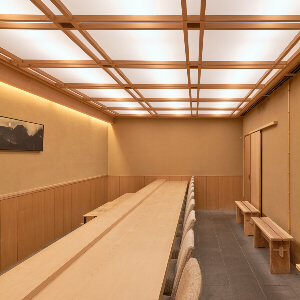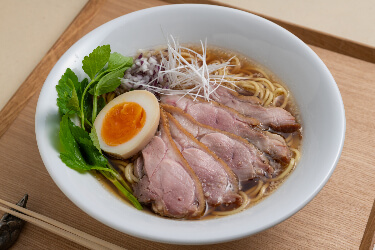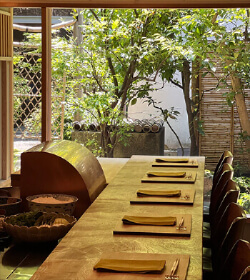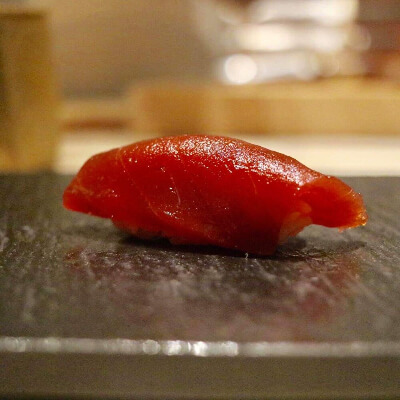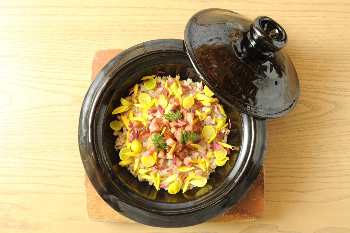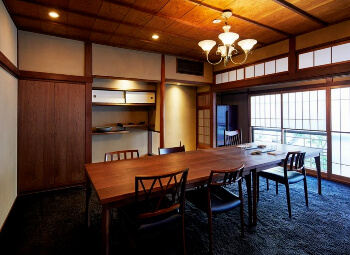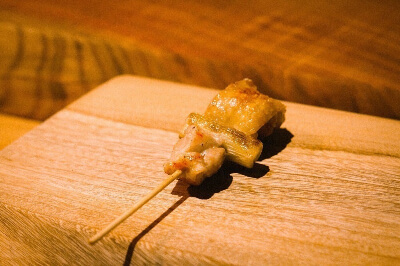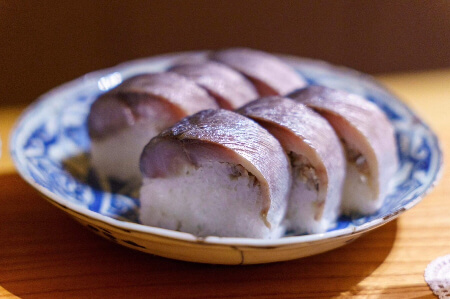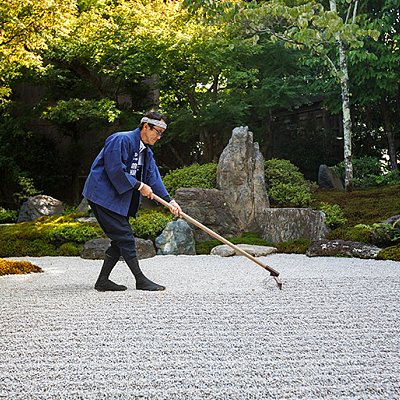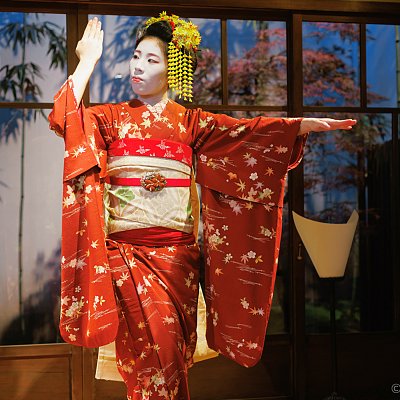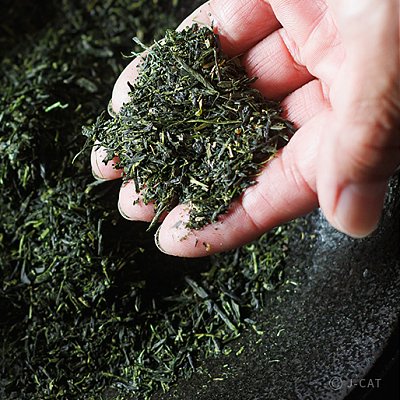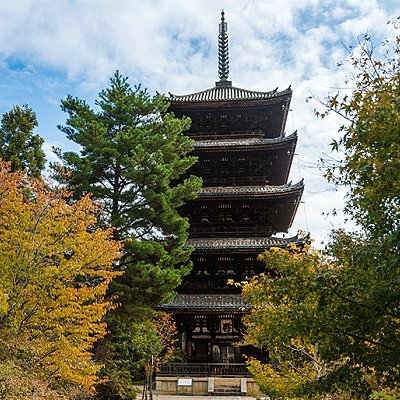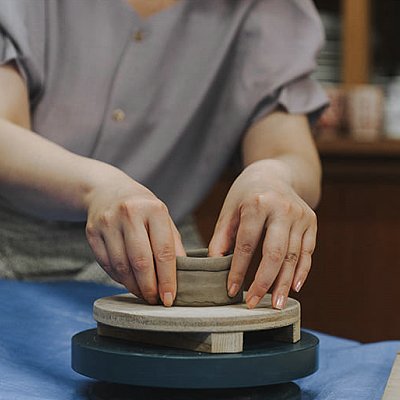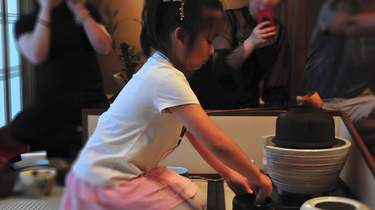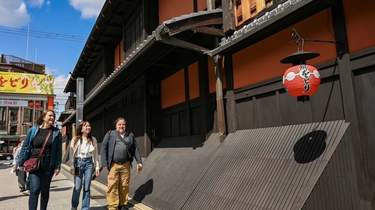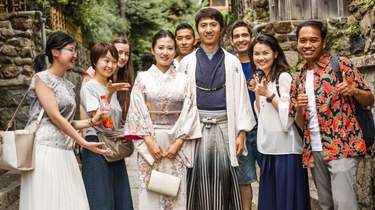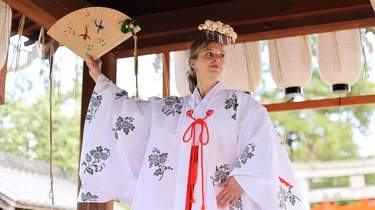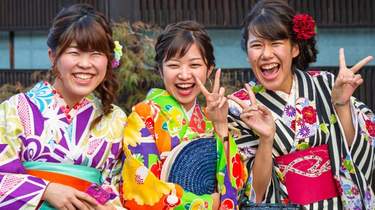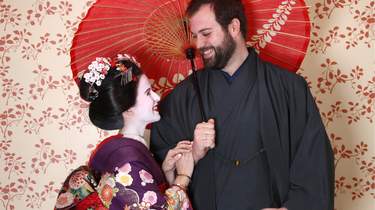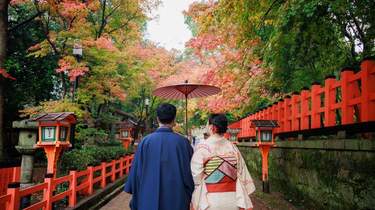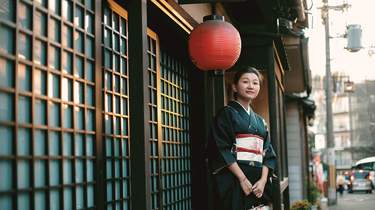Kyoto Crafts
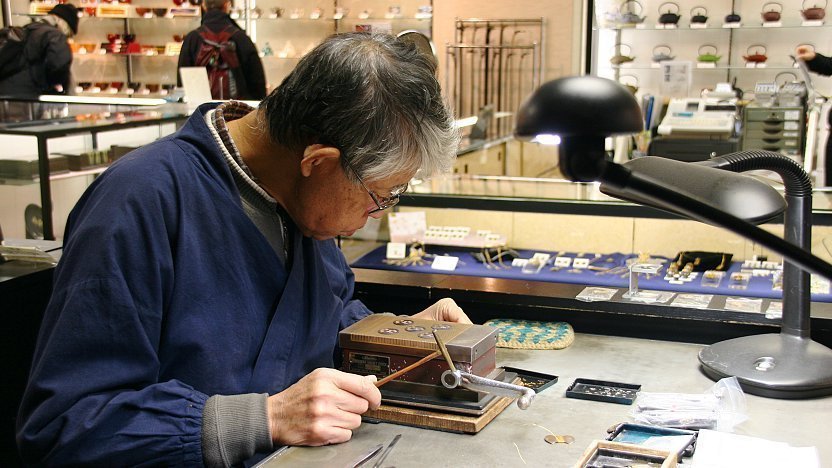
As the capital and the seat of the Imperial Court for over 1000 years, Kyoto has set the quality standard for Japanese arts and crafts. Members of the Imperial Court were particularly influential patrons and practitioners of the arts, and their influence resulted in the development of many popular art forms. The city remains the most important center of traditional Japanese crafts today.
Pottery is a common craft throughout Japan and one of Kyoto's most popular specialties. Of the different styles of Kyoto pottery (kyo-yaki), Kiyomizu pottery is the most famous. This ceramic ware and porcelain is hand painted with elaborate designs and often used in the tea ceremony. Kiyomizu pottery is named after the area around Kiyomizudera Temple, where it was first developed. It is still widely available for purchase in stores around Kiyomizudera.
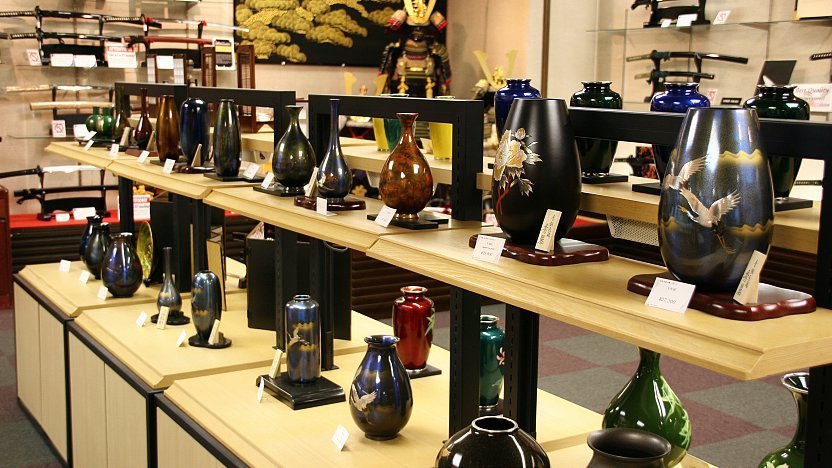
Kyoto's kimono are also regarded to be among Japan's finest. Two methods of kimono manufacturing native to Kyoto are silk weaving (nishijin-ori) and silk dyeing (kyo-yuzen). The silk weaving method developed through the Imperial Court's appetite for beautiful fabrics and elegant clothing and involves dyeing the yarn before weaving it into patterns on fabrics. In the silk dyeing method, the patterns are dyed after the fabric has been produced.
The first evidence of Japanese dolls dates from the Jomon Period. However, Kyoto dolls (kyo-ningyo) became popular during the Heian Period, when they were thought to bring luck and health to children. Gradually, the dolls became popular with daughters of aristocrats in the Imperial Court and the craft was further developed.
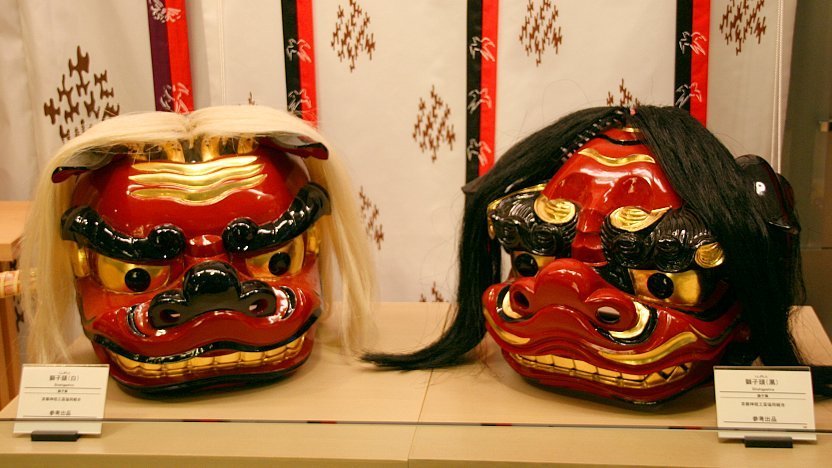
Folding fans (kyo-sensu), decorated with beautiful pictures, were a status symbol at the Imperial Court. They were carried by both men and women and used according to a strict code of decorum. Folding fans from Kyoto are regarded as the country's highest quality fans.
Lacquer ware is another hallmark craft of Japan, and the Kyoto variety, kyo-shikki, is especially popular. Lacquer ware originated in the Nara Period, but it only became widespread about 500 years later. Kyoto lacquer ware has been frequently used in tea ceremonies.
Home to the Emperor for over 1000 years, Kyoto often hosted elaborate Shinto ceremonies and festivities. Specialized Shinto objects, such as masks, crowns and instruments were developed for these events, some of which can be seen in Kyoto's many shrines. The city remains Japan's main producer of Shinto objects today.
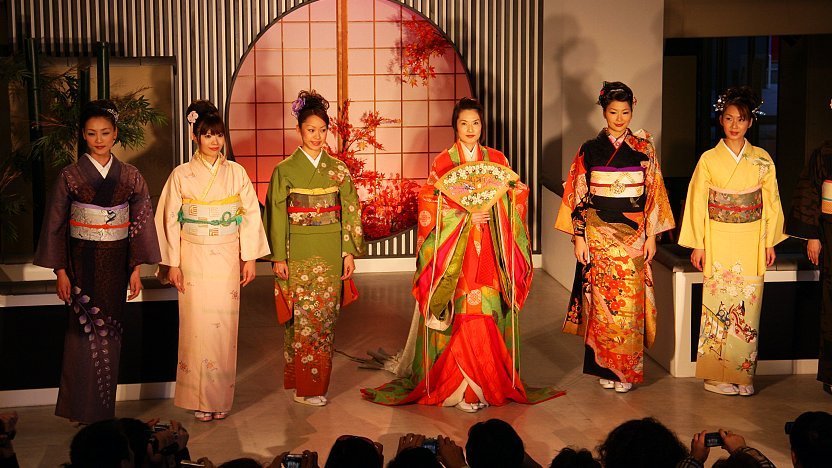
Other Kyoto crafts include ukiyo-e (woodblock prints), Japanese umbrellas (wagasa), various crafts and tools made of bamboo, and washi paper, a thick type of paper used for origami, ukiyo-e prints and many other purposes.
Kyoto has dozens of facilities catering to the sale, creation and teaching of various handicrafts. Besides the usual craft and souvenir shops, some Kyoto craft specialists also offer workshops, allowing guests to try producing their own crafts.
Kyoto craft centers
Getting there and around
Kyoto Museum of Crafts and Design and Kyoto Handicraft Center
The Kyoto Museum of Crafts and Design and Kyoto Handicraft Center stand close to one another and can easily be combined. The museum is located just south of Heian Shrine, while the Handicraft Center is just to the north of it.
By bus from Kyoto Station, Kyoto City Bus number 5 take passengers to Kyotokaikan Bijutsukan-mae bus stop (about 25 minutes, 230 yen).
Both facilities can also be accessed in about ten minutes on foot from Keihan Marutamachi Station on the Keihan Railway Line or Higashiyama Station on the Tozai Subway Line.
Nishijin Textile Center
Take the Karasuma Subway Line from Kyoto Station to Imadegawa Station (9 minutes, 260 yen), from where Nishijin Textile Center is a 10 minute walk west of the junction of Imadegawa and Horikawa streets.
Visitors can also board Kyoto City Bus number 9 from Kyoto Station. Disembark at Horikawa-Imadegawa bus stop (about 25 minutes, 230 yen).
Questions? Ask in our forum.
Links and Resources
Hotels around Kyoto
-
-
![]() SponsoredRyokan TogetsuteiA historical onsen ryokan in front of Togetsukyo Bridge. Enjoy in-room private baths commanding views of Arashiyama and its Kyoto cuisine. Free pick-up from JR station.View siteSponsored
SponsoredRyokan TogetsuteiA historical onsen ryokan in front of Togetsukyo Bridge. Enjoy in-room private baths commanding views of Arashiyama and its Kyoto cuisine. Free pick-up from JR station.View siteSponsored -
![]() Sponsoredarashiyama villa Serenitas kyotoA private wooden rental house with Japanese garden, down an alley from the bustling street of Arashiyama. Located right next to Tenryu-ji the World Heritage.View siteSponsored
Sponsoredarashiyama villa Serenitas kyotoA private wooden rental house with Japanese garden, down an alley from the bustling street of Arashiyama. Located right next to Tenryu-ji the World Heritage.View siteSponsored -
![]() SponsoredRyokan HirashinA traditional hotel with spacious rooms and high speed Wi-Fi. Conveniently located in the heart of Kyoto city. 3min to Shijo Karasuma Sta. and 5min to the famous Nishiki Market.View siteSponsored
SponsoredRyokan HirashinA traditional hotel with spacious rooms and high speed Wi-Fi. Conveniently located in the heart of Kyoto city. 3min to Shijo Karasuma Sta. and 5min to the famous Nishiki Market.View siteSponsored -
![]() SponsoredArashiyama HanaikadaA little, superior ryokan right near Togetsukyo Bridge in Arashiyama. Free transfer from JR station. Private bath and open-air baths available. 5min walk to the Bamboo Groves.View siteSponsored
SponsoredArashiyama HanaikadaA little, superior ryokan right near Togetsukyo Bridge in Arashiyama. Free transfer from JR station. Private bath and open-air baths available. 5min walk to the Bamboo Groves.View siteSponsored -
![]() Sponsored
Sponsored -
![]() SponsoredJapanese hotel, Ryokan NishiyamaExperience the real Japan at our affordable ryokan. Close to major tourist spots in Kyoto.View siteSponsored
SponsoredJapanese hotel, Ryokan NishiyamaExperience the real Japan at our affordable ryokan. Close to major tourist spots in Kyoto.View siteSponsored
-
-
-
![]() Guesthouse KYOTO COMPASSLocated in Kyoto, this traditional Japanese guest house features free Wi-Fi and a free public computer. Shichijo Onmae bus stop is 3 minutesf walk away. A seating area and shared bathroom are provided with each room at Guesthouse KYOTO COMPASS. Free toiletries are provided and blankets are available upon request. Select rooms have a garden view. A shared living area and bicycles are available for guestsf use during their stay at this Kyoto Guesthouse Compass. Access to the shared kitchen is available upon request. The guest house is 4.5 km from Imperial Palace and 2.2 km from Kyoto Station. Nijo Castle and Toji Castle are within a 30 minutesf bus ride away.View on Booking.com
Guesthouse KYOTO COMPASSLocated in Kyoto, this traditional Japanese guest house features free Wi-Fi and a free public computer. Shichijo Onmae bus stop is 3 minutesf walk away. A seating area and shared bathroom are provided with each room at Guesthouse KYOTO COMPASS. Free toiletries are provided and blankets are available upon request. Select rooms have a garden view. A shared living area and bicycles are available for guestsf use during their stay at this Kyoto Guesthouse Compass. Access to the shared kitchen is available upon request. The guest house is 4.5 km from Imperial Palace and 2.2 km from Kyoto Station. Nijo Castle and Toji Castle are within a 30 minutesf bus ride away.View on Booking.com -
![]() Ryokan ToriRyokan Tori is located in Kyoto, 2 km from Kitano Tenmangu Shrine. The property is around 2.3 km from Nijo Castle and Kyoto Imperial Palace. The property is 3.2 km from Kinkaku-ji Temple and 3.7 km from Kyoto International Manga Museum. All guest rooms in the ryokan are fitted with a kettle. Each room has a shared bathroom, while selected rooms are fitted with a balcony and others also offer a garden view. All rooms will provide guests with a fridge. Guests at tori can enjoy an Asian breakfast. Heian Shrine is 5 km from the accommodation. Itami Airport is 50 km from the property.View on Booking.com
Ryokan ToriRyokan Tori is located in Kyoto, 2 km from Kitano Tenmangu Shrine. The property is around 2.3 km from Nijo Castle and Kyoto Imperial Palace. The property is 3.2 km from Kinkaku-ji Temple and 3.7 km from Kyoto International Manga Museum. All guest rooms in the ryokan are fitted with a kettle. Each room has a shared bathroom, while selected rooms are fitted with a balcony and others also offer a garden view. All rooms will provide guests with a fridge. Guests at tori can enjoy an Asian breakfast. Heian Shrine is 5 km from the accommodation. Itami Airport is 50 km from the property.View on Booking.com -
![]() Ryokan Mugen (Adult Only)Mugen is a property that was built 160 years ago, situated in Kyoto, 1 km from Nijo Castle. Every room at Mugen features an en suite shower room, toilet, free toiletries and a hairdryer. Free WiFi is available throughout the entire property. You will find a shared lounge on site and a bar at the annex building. The ryokan also offers bike hire. Imperial Palace is 1.1 km from Mugen, while Kitano Tenmangu Shrine is 1.6 km from the property. The nearest airport is Osaka Itami Airport, 39 km from the property.View on Booking.com
Ryokan Mugen (Adult Only)Mugen is a property that was built 160 years ago, situated in Kyoto, 1 km from Nijo Castle. Every room at Mugen features an en suite shower room, toilet, free toiletries and a hairdryer. Free WiFi is available throughout the entire property. You will find a shared lounge on site and a bar at the annex building. The ryokan also offers bike hire. Imperial Palace is 1.1 km from Mugen, while Kitano Tenmangu Shrine is 1.6 km from the property. The nearest airport is Osaka Itami Airport, 39 km from the property.View on Booking.com -
![]() Mitsuki KyotoOffering a bar and garden view, Mitsuki Kyoto is set in Kyoto, 1.1 km from Nijo Castle and 1.8 km from Kyoto Shigaku Kaikan Conference Hall. Featuring a garden, the 2-star ryokan has air-conditioned rooms with free WiFi, each with a private bathroom. The property is 1.4 km from the city centre and 600 metres from Kyoto International Manga Museum. At the ryokan, the units are fitted with a tatami. A fridge and kettle are also featured. At the ryokan, the units are equipped with bed linen and towels. The ryokan serves a vegetarian and vegan breakfast and breakfast in the room is also available. Kyoto Imperial Palace is 2.1 km from Mitsuki Kyoto, while Heian Shrine is 2.3 km away. Itami Airport is 46 km from the property.View on Booking.com
Mitsuki KyotoOffering a bar and garden view, Mitsuki Kyoto is set in Kyoto, 1.1 km from Nijo Castle and 1.8 km from Kyoto Shigaku Kaikan Conference Hall. Featuring a garden, the 2-star ryokan has air-conditioned rooms with free WiFi, each with a private bathroom. The property is 1.4 km from the city centre and 600 metres from Kyoto International Manga Museum. At the ryokan, the units are fitted with a tatami. A fridge and kettle are also featured. At the ryokan, the units are equipped with bed linen and towels. The ryokan serves a vegetarian and vegan breakfast and breakfast in the room is also available. Kyoto Imperial Palace is 2.1 km from Mitsuki Kyoto, while Heian Shrine is 2.3 km away. Itami Airport is 46 km from the property.View on Booking.com -
![]() Yado KiramachiYado Kiramachi offers accommodation set 600 metres from the centre of Kyoto and provides a garden and a terrace. The air-conditioned accommodation is 600 metres from Kyoto Shigaku Kaikan Conference Hall. The ryokan features family rooms. The units at the ryokan come with a seating area. The units have a coffee machine, a private bathroom and free WiFi, while selected rooms will provide you with a balcony and some have garden views. At the ryokan, all units include bed linen and towels. A bar can be found on-site. Kyoto International Manga Museum is 1.3 km from the ryokan, while Gion Shijo Station is 1.6 km away. Itami Airport is 45 km from the property.View on Booking.com
Yado KiramachiYado Kiramachi offers accommodation set 600 metres from the centre of Kyoto and provides a garden and a terrace. The air-conditioned accommodation is 600 metres from Kyoto Shigaku Kaikan Conference Hall. The ryokan features family rooms. The units at the ryokan come with a seating area. The units have a coffee machine, a private bathroom and free WiFi, while selected rooms will provide you with a balcony and some have garden views. At the ryokan, all units include bed linen and towels. A bar can be found on-site. Kyoto International Manga Museum is 1.3 km from the ryokan, while Gion Shijo Station is 1.6 km away. Itami Airport is 45 km from the property.View on Booking.com -
![]() Komatsu ResidencesLocated within 1 km of Kiyomizu-dera Temple and 1 km of Gion Shijo Station, Komatsu Residences provides rooms with air conditioning and a private bathroom in Kyoto. There is a private entrance at the aparthotel for the convenience of those who stay. Each room is fitted with a terrace with inner courtyard views. The units provide views of the garden and come with a seating area, a washing machine, a fully equipped kitchenette with an oven, and a private bathroom with slippers and a hair dryer. Every unit includes a safety deposit box and free WiFi, while selected rooms come with a balcony. At the aparthotel, every unit has bed linen and towels. Guests can also relax in the garden. Popular points of interest near the aparthotel include Sanjusangen-do Temple, Samurai Kembu Kyoto and Shoren-in Temple. Itami Airport is 45 km away.View on Booking.com
Komatsu ResidencesLocated within 1 km of Kiyomizu-dera Temple and 1 km of Gion Shijo Station, Komatsu Residences provides rooms with air conditioning and a private bathroom in Kyoto. There is a private entrance at the aparthotel for the convenience of those who stay. Each room is fitted with a terrace with inner courtyard views. The units provide views of the garden and come with a seating area, a washing machine, a fully equipped kitchenette with an oven, and a private bathroom with slippers and a hair dryer. Every unit includes a safety deposit box and free WiFi, while selected rooms come with a balcony. At the aparthotel, every unit has bed linen and towels. Guests can also relax in the garden. Popular points of interest near the aparthotel include Sanjusangen-do Temple, Samurai Kembu Kyoto and Shoren-in Temple. Itami Airport is 45 km away.View on Booking.com -
![]() Gallery Nozawa InnGallery Nozawa Inn offers accommodation in Kyoto, 25 minutes on foot from JR Kyoto Station. Free WiFi is available throughout the property. Every room includes a flat-screen TV and air conditioning. Each room is equipped with a private toilet, and bathrooms are shared. For your comfort, you will find free toiletries and a hairdryer. There is luggage storage space at the property. Guests can sample Japanese-style breakfast featuring seasonal ingredients. There is a public bathhouse located a 10-minute walk away. Nijo Castle is 2.4 km from Gallery Nozawa Inn, while Kyoto International Manga Museum is 2.4 km from the property. Osaka Itami Airport is 36 km away.View on Booking.com
Gallery Nozawa InnGallery Nozawa Inn offers accommodation in Kyoto, 25 minutes on foot from JR Kyoto Station. Free WiFi is available throughout the property. Every room includes a flat-screen TV and air conditioning. Each room is equipped with a private toilet, and bathrooms are shared. For your comfort, you will find free toiletries and a hairdryer. There is luggage storage space at the property. Guests can sample Japanese-style breakfast featuring seasonal ingredients. There is a public bathhouse located a 10-minute walk away. Nijo Castle is 2.4 km from Gallery Nozawa Inn, while Kyoto International Manga Museum is 2.4 km from the property. Osaka Itami Airport is 36 km away.View on Booking.com -
![]() Kyo-Anthu InnLocated in Kyoto and within 500 metres of Sanjusangen-do Temple, Kyo-Anthu Inn features a garden, soundproof rooms, and free WiFi. It is set 1.3 km from TKP Garden City Kyoto and provides full-day security. The guest house has family rooms. The guest house will provide guests with air-conditioned units with a desk, a kettle, a fridge, a safety deposit box, a flat-screen TV and a private bathroom with a bidet. There is also a well-fitted kitchenette in some of the units equipped with a microwave and a toaster. At the guest house, all units come with bed linen and towels. Guests at the guest house can enjoy a continental breakfast, and breakfast in the room is also available. Popular points of interest near Kyo-Anthu Inn include Kiyomizu-dera Temple, Kyoto Station and Gion Shijo Station. Itami Airport is 44 km away.View on Booking.com
Kyo-Anthu InnLocated in Kyoto and within 500 metres of Sanjusangen-do Temple, Kyo-Anthu Inn features a garden, soundproof rooms, and free WiFi. It is set 1.3 km from TKP Garden City Kyoto and provides full-day security. The guest house has family rooms. The guest house will provide guests with air-conditioned units with a desk, a kettle, a fridge, a safety deposit box, a flat-screen TV and a private bathroom with a bidet. There is also a well-fitted kitchenette in some of the units equipped with a microwave and a toaster. At the guest house, all units come with bed linen and towels. Guests at the guest house can enjoy a continental breakfast, and breakfast in the room is also available. Popular points of interest near Kyo-Anthu Inn include Kiyomizu-dera Temple, Kyoto Station and Gion Shijo Station. Itami Airport is 44 km away.View on Booking.com -
![]() Hotel MusoWell located in the centre of Kyoto, Hotel Muso provides 3-star accommodation close to Gion Shijo Station and Kyoto Shigaku Kaikan Conference Hall. The property is around 1.8 km from TKP Garden City Kyoto, 2 km from Kyoto International Manga Museum and 2.7 km from Kyoto Station. Providing free WiFi throughout the property, the non-smoking hotel features a hot tub. The hotel will provide guests with air-conditioned rooms offering a desk, a coffee machine, a fridge, a safety deposit box, a flat-screen TV and a private bathroom with a bidet. Each room has a kettle, while selected rooms come with a kitchen with a microwave, a minibar and a stovetop. Popular points of interest near Hotel Muso include Sanjusangen-do Temple, Samurai Kembu Kyoto and Kiyomizu-dera Temple. Itami Airport is 45 km away.View on Booking.com
Hotel MusoWell located in the centre of Kyoto, Hotel Muso provides 3-star accommodation close to Gion Shijo Station and Kyoto Shigaku Kaikan Conference Hall. The property is around 1.8 km from TKP Garden City Kyoto, 2 km from Kyoto International Manga Museum and 2.7 km from Kyoto Station. Providing free WiFi throughout the property, the non-smoking hotel features a hot tub. The hotel will provide guests with air-conditioned rooms offering a desk, a coffee machine, a fridge, a safety deposit box, a flat-screen TV and a private bathroom with a bidet. Each room has a kettle, while selected rooms come with a kitchen with a microwave, a minibar and a stovetop. Popular points of interest near Hotel Muso include Sanjusangen-do Temple, Samurai Kembu Kyoto and Kiyomizu-dera Temple. Itami Airport is 45 km away.View on Booking.com -
![]() Yadoya KikokusoSituated in Kyoto, 700 metres from TKP Garden City Kyoto and 2.1 km from the centre, Yadoya Kikokuso features air-conditioned accommodation with free WiFi, and a garden. The 3-star ryokan has garden views and is 1.1 km from Sanjusangen-do Temple. Kiyomizu-dera Temple is 2.2 km away and Kyoto International Manga Museum is 2.7 km from the ryokan. At the ryokan, every unit has a tatami and a flat-screen TV. There is a private bathroom with shower in some units, along with slippers, a hair dryer and free toiletries. At the ryokan, every unit comes with bed linen and towels. Popular points of interest near the ryokan include Kyoto Station, Gion Shijo Station and Kyoto Shigaku Kaikan Conference Hall. Itami Airport is 44 km from the property.View on Booking.com
Yadoya KikokusoSituated in Kyoto, 700 metres from TKP Garden City Kyoto and 2.1 km from the centre, Yadoya Kikokuso features air-conditioned accommodation with free WiFi, and a garden. The 3-star ryokan has garden views and is 1.1 km from Sanjusangen-do Temple. Kiyomizu-dera Temple is 2.2 km away and Kyoto International Manga Museum is 2.7 km from the ryokan. At the ryokan, every unit has a tatami and a flat-screen TV. There is a private bathroom with shower in some units, along with slippers, a hair dryer and free toiletries. At the ryokan, every unit comes with bed linen and towels. Popular points of interest near the ryokan include Kyoto Station, Gion Shijo Station and Kyoto Shigaku Kaikan Conference Hall. Itami Airport is 44 km from the property.View on Booking.com
-
Kyoto Restaurants
-
-
![]() Sushi HayashiAwarded One Star in 2024 - A unique sushi restaurant that blends traditional Edomae (Tokyo-style) sushi with Kyoto-style sushi, such as mackerel sushi and steamed sushi, in its courses. The head chef, who trained as a sushi artisan in Switzerland, carefully selects Swiss wines, making them a perfect pairing to enjoy with the meal.View on JapanEatinerary
Sushi HayashiAwarded One Star in 2024 - A unique sushi restaurant that blends traditional Edomae (Tokyo-style) sushi with Kyoto-style sushi, such as mackerel sushi and steamed sushi, in its courses. The head chef, who trained as a sushi artisan in Switzerland, carefully selects Swiss wines, making them a perfect pairing to enjoy with the meal.View on JapanEatinerary -
![]() Noguchi TsunaguAwarded One Star in 2024 - The sister restaurant of the highly exclusive Japanese cuisine establishment, Kyotenjin Noguchi. While maintaining the culinary essence of the main branch, this kappo-style restaurant incorporates ingredients from the chefâs hometown in the Goto Islands. Its signature dish, Nikusui, is a masterpiece made from carefully prepared, top-quality A5-grade sirloin.View on JapanEatinerary
Noguchi TsunaguAwarded One Star in 2024 - The sister restaurant of the highly exclusive Japanese cuisine establishment, Kyotenjin Noguchi. While maintaining the culinary essence of the main branch, this kappo-style restaurant incorporates ingredients from the chefâs hometown in the Goto Islands. Its signature dish, Nikusui, is a masterpiece made from carefully prepared, top-quality A5-grade sirloin.View on JapanEatinerary -
![]() Kamoryori TabuchiWithin a historic wooden house over 100 years old, savor exquisite dishes crafted with the finest premium brand duck, Kawachi Duck. Raised on feed free from pesticides and delivered fresh every morning, Kawachi Duck is so fresh it can even be enjoyed raw. Indulge in a superb multi-course duck cuisine experience that only a specialty restaurant can offer.View on JapanEatinerary
Kamoryori TabuchiWithin a historic wooden house over 100 years old, savor exquisite dishes crafted with the finest premium brand duck, Kawachi Duck. Raised on feed free from pesticides and delivered fresh every morning, Kawachi Duck is so fresh it can even be enjoyed raw. Indulge in a superb multi-course duck cuisine experience that only a specialty restaurant can offer.View on JapanEatinerary -
![]() Enyuan KobayashiAwarded One Star in 2024 - Under the skillful craftsmanship of a master chef trained at renowned establishments, this restaurant offers tempura that highlights seasonal ingredients, including richly sweet tiger prawns and their signature sea urchin wrapped in seaweed. Mid-course, the menu also features exquisite simmered dishes and sashimi.View on JapanEatinerary
Enyuan KobayashiAwarded One Star in 2024 - Under the skillful craftsmanship of a master chef trained at renowned establishments, this restaurant offers tempura that highlights seasonal ingredients, including richly sweet tiger prawns and their signature sea urchin wrapped in seaweed. Mid-course, the menu also features exquisite simmered dishes and sashimi.View on JapanEatinerary -
![]() Sushi RakumiAwarded One Star in 2024 - You can savor a creative omakase course that combines refined Japanese cuisine with Edomae sushi, crafted by a highly skilled chef who trained at Japanese restaurants and sushi establishments that have earned three stars. Ingredients are primarily sourced from Kyoto Central Market, with seasonal, high-quality ingredients also procured from Tokyo's Toyosu Market and Yaizu Market in Shizuoka.View on JapanEatinerary
Sushi RakumiAwarded One Star in 2024 - You can savor a creative omakase course that combines refined Japanese cuisine with Edomae sushi, crafted by a highly skilled chef who trained at Japanese restaurants and sushi establishments that have earned three stars. Ingredients are primarily sourced from Kyoto Central Market, with seasonal, high-quality ingredients also procured from Tokyo's Toyosu Market and Yaizu Market in Shizuoka.View on JapanEatinerary -
![]() Kanamean NishitomiyaAwarded One Star in 2024 - Sophisticated kaiseki cuisine experienced at a ryokan. Combining tuna with caviar or pairing soba noodles with truffles, the dishes showcase a creative approach that explores unique combinations and flavors. The only establishment in Kyoto affiliated with Relais & Chateaux, where the owner and proprietress draw on their experiences gained abroad to collaborate with chefs in crafting the menu.View on JapanEatinerary
Kanamean NishitomiyaAwarded One Star in 2024 - Sophisticated kaiseki cuisine experienced at a ryokan. Combining tuna with caviar or pairing soba noodles with truffles, the dishes showcase a creative approach that explores unique combinations and flavors. The only establishment in Kyoto affiliated with Relais & Chateaux, where the owner and proprietress draw on their experiences gained abroad to collaborate with chefs in crafting the menu.View on JapanEatinerary -
![]() VenaAwarded One Star in 2024 - A restaurant founded by a chef and sommelier born and raised in Kyoto, built on the concept of carefully selected seasonal ingredients and aged Italian wines. In an elegant space adorned with Scandinavian vintage furniture, guests can enjoy authentic Italian cuisine crafted with an abundance of seasonal ingredients unique to each time of year. Awarded One Star in 2024.View on JapanEatinerary
VenaAwarded One Star in 2024 - A restaurant founded by a chef and sommelier born and raised in Kyoto, built on the concept of carefully selected seasonal ingredients and aged Italian wines. In an elegant space adorned with Scandinavian vintage furniture, guests can enjoy authentic Italian cuisine crafted with an abundance of seasonal ingredients unique to each time of year. Awarded One Star in 2024.View on JapanEatinerary -
![]() Torisho SaiA newly spotlighted restaurant opened in 2024, part of the group of Yakitori Ichimatsu, one of Japan's most renowned yakitori establishments. Housed in a stylishly renovated traditional Japanese home, the restaurant serves yakitori made with Akitaâs "Hinai Jidori," one of Japanâs top three premium chicken breeds, aged for about three days to enhance its flavor.View on JapanEatinerary
Torisho SaiA newly spotlighted restaurant opened in 2024, part of the group of Yakitori Ichimatsu, one of Japan's most renowned yakitori establishments. Housed in a stylishly renovated traditional Japanese home, the restaurant serves yakitori made with Akitaâs "Hinai Jidori," one of Japanâs top three premium chicken breeds, aged for about three days to enhance its flavor.View on JapanEatinerary -
![]() NakatsukaAwarded One Star in 2024 - A one-of-a-kind restaurant where you can enjoy innovative cuisine crafted by the highly skilled Chef Mr. Nakatsuka, who honed his expertise at domestic and international three-star and two-star establishments. The restaurant is themed around "aroma" and features an open kitchen, designed to share the scents of the cooking process with its guests.View on JapanEatinerary
NakatsukaAwarded One Star in 2024 - A one-of-a-kind restaurant where you can enjoy innovative cuisine crafted by the highly skilled Chef Mr. Nakatsuka, who honed his expertise at domestic and international three-star and two-star establishments. The restaurant is themed around "aroma" and features an open kitchen, designed to share the scents of the cooking process with its guests.View on JapanEatinerary -
![]() MiyawakiA restaurant with a unique concept of offering traditional Kyoto cuisine in Tokyo, blending authentic techniques with innovative approaches. It is also known for attracting numerous prominent figures from various fields, including renowned Japanese music producers and soccer players.View on JapanEatinerary
MiyawakiA restaurant with a unique concept of offering traditional Kyoto cuisine in Tokyo, blending authentic techniques with innovative approaches. It is also known for attracting numerous prominent figures from various fields, including renowned Japanese music producers and soccer players.View on JapanEatinerary
-
Experiences around Kyoto
-
-
![]() SponsoredLearn the Art of Karesansui Dry-Garden Raking from a Kyoto MasterKyotofs Sagano-Arashiyama district is an iconic landmark, beloved by visitors from all over Japan and the world for its harmony of rich natural scenery and historic architecture. Here, the cultural property garden restoration and maintenance organization Sone Zoen – responsible for designing and managing the gardens of famous shrines and temples across Kyoto – runs the gHoganh facility, which offers visitors the chance to experience authentic Zen sand raking in a traditional Japanese house and garden. Find inner tranquility as you contemplate the gardenfs beauty, before experiencing the spirit of Zen and the historic tradition of karesansui dry gardening through sand-raking with a master.View experienceSponsored
SponsoredLearn the Art of Karesansui Dry-Garden Raking from a Kyoto MasterKyotofs Sagano-Arashiyama district is an iconic landmark, beloved by visitors from all over Japan and the world for its harmony of rich natural scenery and historic architecture. Here, the cultural property garden restoration and maintenance organization Sone Zoen – responsible for designing and managing the gardens of famous shrines and temples across Kyoto – runs the gHoganh facility, which offers visitors the chance to experience authentic Zen sand raking in a traditional Japanese house and garden. Find inner tranquility as you contemplate the gardenfs beauty, before experiencing the spirit of Zen and the historic tradition of karesansui dry gardening through sand-raking with a master.View experienceSponsored -
![]() SponsoredMaiko Tea and Entertainment with Behind-the-Scenes Insights at Kyotofs Oldest Geisha DistrictGain valuable insights into Kyotofs historic geisha culture at Umeno, a traditional ochaya banquet house in Kamishichiken, the oldest of Kyotofs five geisha districts. Although ochaya generally turn away new customers, Umenofs proprietress-to-be invites you to watch a maikofs (apprentice geisha) elegant dance and learn about her culture. Then, chat with them over sweets and matcha tea personally prepared by the maiko. After trying a traditional party game and snapping some pictures, hear about Umenofs sustainable practices and enter the dressing room used by its maiko, an extremely rare chance to go behind the scenes.View experienceSponsored
SponsoredMaiko Tea and Entertainment with Behind-the-Scenes Insights at Kyotofs Oldest Geisha DistrictGain valuable insights into Kyotofs historic geisha culture at Umeno, a traditional ochaya banquet house in Kamishichiken, the oldest of Kyotofs five geisha districts. Although ochaya generally turn away new customers, Umenofs proprietress-to-be invites you to watch a maikofs (apprentice geisha) elegant dance and learn about her culture. Then, chat with them over sweets and matcha tea personally prepared by the maiko. After trying a traditional party game and snapping some pictures, hear about Umenofs sustainable practices and enter the dressing room used by its maiko, an extremely rare chance to go behind the scenes.View experienceSponsored -
![]() SponsoredTea Plantation Tour and Organic Green Tea Tasting in the Birthplace of Japanese Green Tea, KyotoFounded in 1658 in the Kyoto town of Ujitawara – the birthplace of Japanese green tea – the Kaki-i plantation grows tea completely without the use of pesticides. In this experience, visitors can join the 21st generation head of the plantation to tour its fields and see historical sites associated with Soen Nagatani, who first developed the Japanese green tea enjoyed around the world today. If your seasonal timing is right, you can also observe the tea harvest or the processing of the leaf. Finally, enjoy a comparative tasting of 3 to 4 of Kaki-ifs organic teas in a 150-year-old traditional Japanese home, and learn how best to enjoy each.View experienceSponsored
SponsoredTea Plantation Tour and Organic Green Tea Tasting in the Birthplace of Japanese Green Tea, KyotoFounded in 1658 in the Kyoto town of Ujitawara – the birthplace of Japanese green tea – the Kaki-i plantation grows tea completely without the use of pesticides. In this experience, visitors can join the 21st generation head of the plantation to tour its fields and see historical sites associated with Soen Nagatani, who first developed the Japanese green tea enjoyed around the world today. If your seasonal timing is right, you can also observe the tea harvest or the processing of the leaf. Finally, enjoy a comparative tasting of 3 to 4 of Kaki-ifs organic teas in a 150-year-old traditional Japanese home, and learn how best to enjoy each.View experienceSponsored -
![]() SponsoredPrivate Stay at World Heritage Site Ninna-ji With Special Tour and Bewitching Light-UpExperience Ninna-ji Temple, a UNESCO World Heritage Site with deep links to the imperial family, like no other through an overnight stay inside the grounds. During a special private tour led by one of its monks, enter some of the oldest surviving temple buildings in all of Japan, such as the Great Hall (a National Treasure), which is normally closed to the public. Then, the grounds are yours for the night - after the sun sets, explore the lit-up grounds and take advantage of the lovingly curated accommodation, a former temple samurai residence (dinner also available as an optional add-on). Finally, refresh yourself by joining the monksf morning service and Dharma sermon, as well as drawing rock patterns.View experienceSponsored
SponsoredPrivate Stay at World Heritage Site Ninna-ji With Special Tour and Bewitching Light-UpExperience Ninna-ji Temple, a UNESCO World Heritage Site with deep links to the imperial family, like no other through an overnight stay inside the grounds. During a special private tour led by one of its monks, enter some of the oldest surviving temple buildings in all of Japan, such as the Great Hall (a National Treasure), which is normally closed to the public. Then, the grounds are yours for the night - after the sun sets, explore the lit-up grounds and take advantage of the lovingly curated accommodation, a former temple samurai residence (dinner also available as an optional add-on). Finally, refresh yourself by joining the monksf morning service and Dharma sermon, as well as drawing rock patterns.View experienceSponsored -
![]() SponsoredKiyomizu Ware Pottery Experience at a Century-Old Kiln in KyotoBased in Kyoto, the reputable Shoukoku Kiln, which was established more than 100 years ago, creates exquisite ceramic tableware that high-end ryotei restaurants use for kappo fine-dining cuisine. At this prestigious kiln that preserves tradition while constantly seeking innovation, discover the secrets to long-lasting, high-quality ceramics as you hand-build or paint pottery under the guidance of a skilled artisan who has mastered the art of Kyo-yaki and Kiyomizu-yaki ceramic ware.View experienceSponsored
SponsoredKiyomizu Ware Pottery Experience at a Century-Old Kiln in KyotoBased in Kyoto, the reputable Shoukoku Kiln, which was established more than 100 years ago, creates exquisite ceramic tableware that high-end ryotei restaurants use for kappo fine-dining cuisine. At this prestigious kiln that preserves tradition while constantly seeking innovation, discover the secrets to long-lasting, high-quality ceramics as you hand-build or paint pottery under the guidance of a skilled artisan who has mastered the art of Kyo-yaki and Kiyomizu-yaki ceramic ware.View experienceSponsored
-
-
-
![]() Kyoto Kimono ExperiencebJapanese MakeoverbPhoto ShootbChinesebJapanesebEnglish (Kimono Momoka)Basic okomon kimono plan: [Included in the fee]: Only okomon kimono and half-width obi are included [Excluded from the fee]: Small bag, tabi socks, rental sandals, muscle wear, and corrections are not includedView on Klook
Kyoto Kimono ExperiencebJapanese MakeoverbPhoto ShootbChinesebJapanesebEnglish (Kimono Momoka)Basic okomon kimono plan: [Included in the fee]: Only okomon kimono and half-width obi are included [Excluded from the fee]: Small bag, tabi socks, rental sandals, muscle wear, and corrections are not includedView on Klook -
![]() Matcha Tea Ceremony Experience (Kyoto)You can enjoy watching the tea ceremony by the teacher and experience the tea ceremony. Comes with matcha and Japanese sweets!View on Klook
Matcha Tea Ceremony Experience (Kyoto)You can enjoy watching the tea ceremony by the teacher and experience the tea ceremony. Comes with matcha and Japanese sweets!View on Klook -
![]() Private Kyoto Gion Highlights & Hidden Gems Tour with Local GuideExperience the best of Gionfs nightlife scene with a local insider to guide youView on Klook
Private Kyoto Gion Highlights & Hidden Gems Tour with Local GuideExperience the best of Gionfs nightlife scene with a local insider to guide youView on Klook -
![]() Kyoto City Highlights & Hidden Gems Private Custom Tour with a LocalGet to know the real Kyoto with your host (a city local) and avoid the tourist traps, whilst still seeing the highlights!View on Klook
Kyoto City Highlights & Hidden Gems Private Custom Tour with a LocalGet to know the real Kyoto with your host (a city local) and avoid the tourist traps, whilst still seeing the highlights!View on Klook -
![]() Kyoto Arashiyama Walking Tour: Bamboo Forest, Monkeys, Zen & SecretsSaga-Arashiyama Station: Meet at the Saga-Arashiyama Station, where you can take a few minutes to explore the surrounding area and get acquainted with your group.View on Klook
Kyoto Arashiyama Walking Tour: Bamboo Forest, Monkeys, Zen & SecretsSaga-Arashiyama Station: Meet at the Saga-Arashiyama Station, where you can take a few minutes to explore the surrounding area and get acquainted with your group.View on Klook -
![]()
-
![]() Kyoto 4 Hour Low-Down Private Walking TourSee a tailor-made selection of sites, picked by your local guide, that show every side of KyotoView on Klook
Kyoto 4 Hour Low-Down Private Walking TourSee a tailor-made selection of sites, picked by your local guide, that show every side of KyotoView on Klook -
![]() Maiko and a Samurai Makeover Experience for CoupleChange into a beautiful Maiko and a cool SamuraView on Klook
Maiko and a Samurai Makeover Experience for CoupleChange into a beautiful Maiko and a cool SamuraView on Klook -
![]() Kimono Rental Experience by Wakana Kimono in KyotoExplore the streets of Kyoto while wearing a charming kimono when you book this experience!View on Klook
Kimono Rental Experience by Wakana Kimono in KyotoExplore the streets of Kyoto while wearing a charming kimono when you book this experience!View on Klook -
![]() Kyoto Photography ServicesThe photographer has lived in Japan for many years and knows many niche places in Kyoto. If necessary, you can negotiate with the photographerView on Klook
Kyoto Photography ServicesThe photographer has lived in Japan for many years and knows many niche places in Kyoto. If necessary, you can negotiate with the photographerView on Klook
-
